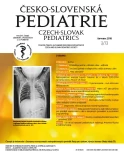Retrospective analysis of minor head injuries at the Department of Paediatrics, the Teaching Hospital and the Faculty of Medicine, Charles University in Pilsen in the years 2010–2014
Authors:
D. Cvalínová; V. Schwarzová; J. Fremuth; E. Sládková; J. Sýkora
Authors‘ workplace:
Dětská klinika, Fakultní nemocnice v Plzni, Univerzita Karlova v Praze, Lékařská fakulta v Plzni
Published in:
Čes-slov Pediat 2018; 73 (3): 132-138.
Category:
Original Papers
Overview
Study objective:
Describe a patient sample hospitalized at the Nursery and Infant Unit of the Department of Paediatrics, the Teaching Hospital and the Faculty of Medicine, Charles University in Pilsen for minor head injuries after falls from small height for the years 2010–2014, and, on the basis of the PECARN score and own sample data analysis, define proper management of these patients.
Methods:
Retrospective analysis of medical records of patients up to the age of 1 year, hospitalized for minor head injuries. Descriptive evaluation of sample: evaluation of the mechanism of injuries (fall height, impact surface), evaluation of clinical findings (localization and extent of injuries, neurological findings), analysis of the results of laboratory and imaging assessments (ultrasound examination of brain, X-ray of the skull, CT/MRI of brain), and their recovery.
Results:
In the years 2010–2014, 5933 patients were hospitalized at the Nursery Unit of the Department of Paediatrics, the Teaching Hospital and the Faculty of Medicine in Pilsen, of which 614 for minor head injuries after falls from height. Most of the injuries of these children occurred at home. The sample consisted of 53% of boys and 47% of girls. In 7 cases, the children were indicated to CT (3) and MRI (4) of the head, and intracranial bleeding was reported in 3 patients. Two patients were indicated for surgical intervention. A statistically significant correlation was demonstrated between the localisation of injury and presence of fissure. Compared to patients with frontal injuries (p<0.0004), the patients with non-frontal injuries had a significantly higher incidence of fissure.
Conclusion:
On the basis of the retrospective analysis of our experience with children up to 1 year of age, hospitalized after falls on the head, we have proved that proper evaluation of medical history and clinical status are crucial to assess the risk of intracranial complications, and other additional examinations (for example: USG of the brain) are not beneficial in this respect. The PECARN scoring system allows safe identification of patients indicated for graphic scan of the brain (CT/MRI). Children with skull fissures belong to the group of patients with a higher risk of complications.
Keywords:
minor head injury, head, PECARN score, risk, child
Sources
1. Centers for Disease Control and Prevention. http://www.cdc.gov//TraumaticBrainInjury/index.html.
2. Zvadová Z, Janoušek S. Prevence úrazů u dětí a dospívajících ČR. http://www.szu.cz/tema/podpora-zdravi/prevence-urazu-u-deti-a-dospivajicich-cr.
3. Srb T. Úrazovost dětí a mladistvých do roku 2009. http://www.uzis.cz//rychle-informace/urazovost-deti-mladistvych-roku-2009.
4. Schutzman SA, et al. Evaluation and management of children younger than two years old with apparently minor head trauma: proposed guidelines. Pediatrics 2001; 107 : 983–993.
5. Kuppermann N, et al. Identification of children at very low risk of clinically-important brain injuries after head trauma: a prospective cohort study. Lancet 2000; 374 : 1160–1170.
6. Babl FE, et al. Accuracy of PECARN, CATCH, and CHALICE head injury decision rules in children: a prospective cohort study. Lancet 2017; 389 : 2393–2402.
7. Burns ECM, et al. Scalp hematoma characteristics associated with intracranial injury in pediatric minor head injury. Acad Emerg Med 2016; 23 : 576–583.
8. Erlichman DB, Blumfield E, Rajpathak S, Weiss A. Association between linear skull fractures and intracranial hemorrhage in children with minor head trauma. Pediatr Radiol 2010; 40 : 1375–1379.
9. Arneitz C, Sinzig M, Fasching G. Diagnostic and clinical management of skull fractures in children. J Clin Imaging Sci 2016; 6 : 47.
10. Brenner D, Elliston C, Hall E, Berdon W. Estimated risks of radiation-induced fatal cancer from pediatric CT. AJR Am J Roentgenol 2001; 176 : 289–296.
11. Rabiner JE, Friedman LM, Khine H, et al. Accuracy of point-of-care ultrasound for diagnosis of skull fractures in children. Pediatrics 2013; 131: e1757–1764.
12. Boggs W. Point-of-care ultrasound finds skull fractures in children. Medscape Medical News. <http://www.medscape.com/viewarticle/804784>
13. Lyttle MD, Crowe L, Oakley E, et al. Comparing CATCH, CHALICE and PECARN clinical decision rules for paediatric head injuries. Emerg Med J 2012; 29 : 785–794.
14. Dayan PS, et al. Risk of traumatic brain injuries in children younger than 24 months with isolated scalp hematomas. Ann Emerg Med 2014; 64 : 153–162.
15. Schutzman SA, Greenes DS. Pediatric minor head trauma. Ann Emerg Med 2001; 37 : 65–74.
16. Greenes DS, Schutzman SA. Clinical significance of scalp abnormalities in asymptomatic head-injured infants. Pediatr Emerg Care 2001; 17 : 88–92.
17. Bin SS, Schutzman SA, Greenes DS. Validation of a clinical score to predict skull fracture in head-injured infants. Pediatr Emerg Care 2010; 26 : 633–639.
Labels
Neonatology Paediatrics General practitioner for children and adolescentsArticle was published in
Czech-Slovak Pediatrics

2018 Issue 3
- What Effect Can Be Expected from Limosilactobacillus reuteri in Mucositis and Peri-Implantitis?
- The Importance of Limosilactobacillus reuteri in Administration to Diabetics with Gingivitis
Most read in this issue
- C3 glomerulopathy – a new clinical entity
- Current approach to asthma diagnosis and treatment in children
- News in cardiopulmonary resuscitation – „guidelines 2018“
- Macro AST – cause of asymptomatic aspartate aminotransferase elevation – case report
